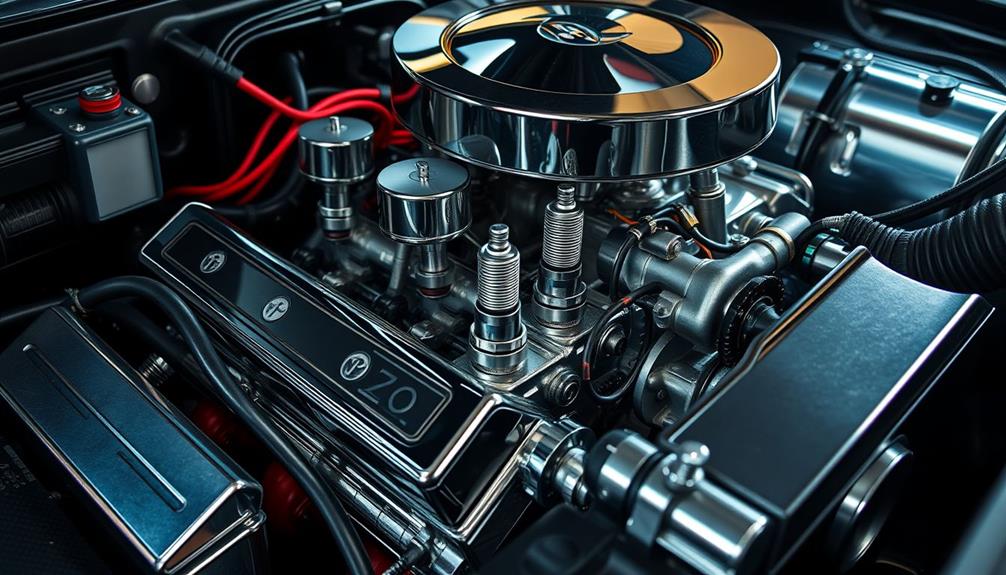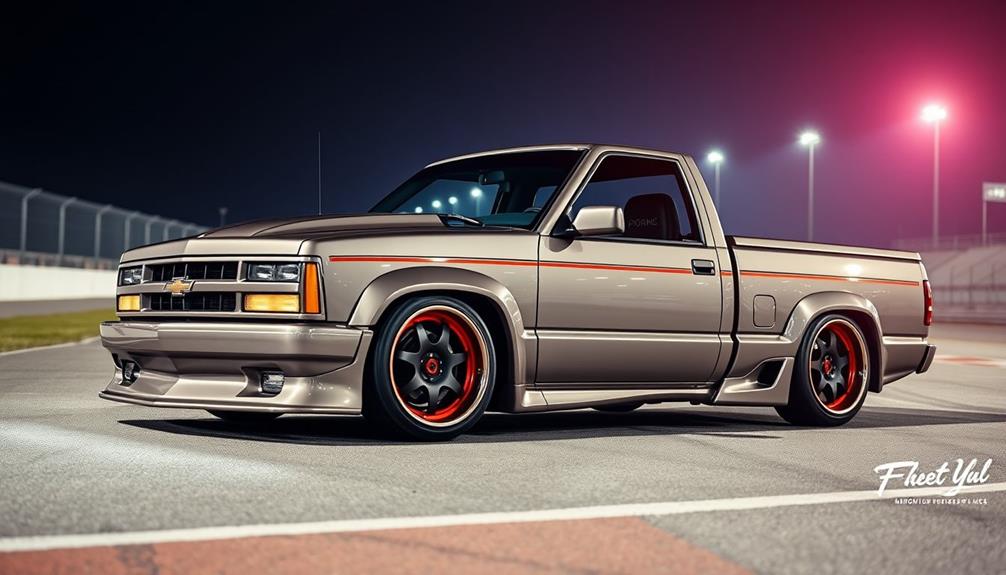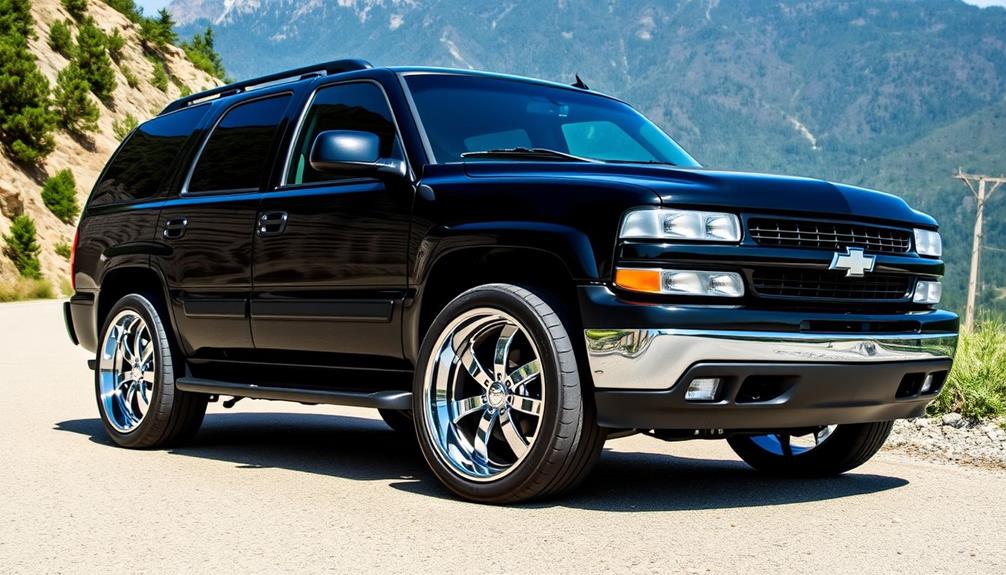Tuning your S10 Chevrolet is about transforming your compact pickup into a powerhouse. Start by upgrading to Vortec heads to enhance airflow and increase horsepower. Installing a cold air intake optimizes combustion, while performance headers and a 2.5-inch cat-back exhaust system improve exhaust flow and reduce back pressure. Don't forget to enhance your ignition system with quality spark plugs and custom chip tuning for better fuel delivery. Regularly maintaining components like O2 sensors guarantees you get the best performance and fuel efficiency. Curious about specific modifications and community insights that can take your S10 even further?
Key Takeaways
- Upgrade to Vortec heads for improved airflow, horsepower, and torque in your S10 Chevrolet.
- Install a cold air intake to optimize combustion and enhance overall engine performance.
- Replace stock headers with performance headers to improve exhaust gas flow and efficiency.
- Regularly check and replace O2 sensors to ensure ideal air-fuel mixture and boost fuel mileage.
- Engage with the S10 community for insights on tuning and modifications to enhance performance.
Engine Modifications
When it comes to engine modifications for your S10 Chevrolet, upgrading to Vortec heads from 1996 and newer can make a world of difference. These heads offer superior flow characteristics compared to stock heads, greatly enhancing horsepower and torque.
If you're considering a V8 swap, Vortec heads can be a solid foundation for that upgrade, allowing your engine to breathe better and perform more efficiently.
Alongside the head upgrade, you might want to install a cold air intake. This modification can further increase airflow to your engine, optimizing combustion and boosting overall performance.
Remember, while retaining stock heads may seem convenient for future supercharger applications, switching to Vortec heads generally yields better results in the long run.
Don't overlook the importance of using forged pistons and rods during your modifications. They enhance durability, especially if you're pushing for high-performance upgrades.
Regularly testing and replacing worn engine components, like O2 sensors, can also improve fuel mileage and performance.
Exhaust System Upgrades

Upgrading your S10's exhaust system can release even more performance potential after enhancing the engine.
Start by replacing the stock headers with performance headers. This change alleviates restrictions, enabling better exhaust gas evacuation and improving engine response. You'll notice more power and efficiency almost immediately.
Next, consider installing a mandrel-bent aftermarket Y-pipe. This upgrade considerably improves exhaust flow compared to the stock accordion-bent design, further enhancing your truck's performance.
Pair this with a high-flow catalytic converter to boost exhaust efficiency, allowing your engine to breathe better and deliver more power.
A 2.5-inch cat-back exhaust system is another outstanding option. It reduces back pressure while enhancing exhaust flow, leading to noticeable hp gains and torque improvements.
Remember, effective exhaust upgrades not only improve performance but also give your S10 a more aggressive sound.
Lastly, regular maintenance of your exhaust system is essential. Check for leaks and blockages to maintain peak performance and efficiency.
Ignition Enhancements

Ignition enhancements play an essential role in maximizing your S10's performance. One of the first upgrades you should consider is replacing your ignition wires with low-resistance options. This change improves spark delivery to the engine, resulting in a more efficient combustion process.
Pairing this with high-quality spark plugs, like AC Delco, guarantees peak combustion efficiency, which can boost your fuel economy and overall performance.
Another effective upgrade is installing a performance ignition coil. This component increases spark energy, leading to more powerful combustion and enhancing your engine's output.
Additionally, custom chip tuning can refine your ignition timing and fuel delivery, delivering noticeable gains in horsepower and torque.
Don't overlook the importance of regularly replacing worn O2 sensors. They greatly impact the air-fuel mixture, and staying on top of this maintenance can further improve your engine performance and fuel mileage.
Performance Maintenance

Regular maintenance is crucial for keeping your S10 running at its best. By focusing on performance maintenance, you can enhance your vehicle's efficiency and longevity. Start with checking your air filter regularly; a clean air filter maximizes airflow, improving acceleration and fuel economy. Upgrading to low-resistance ignition wires and high-quality spark plugs like AC Delco can greatly boost engine performance. Don't overlook the importance of replacing worn O2 sensors, as they improve the air-fuel mixture and enhance overall fuel mileage.
Here's a quick reference table for key performance maintenance tasks:
| Maintenance Task | Importance |
|---|---|
| Change Air Filter | Maximizes airflow and improves fuel economy |
| Replace O2 Sensors | Guarantees ideal air-fuel mixture |
| Upgrade Ignition Wires | Enhances engine efficiency |
| Test Engine Components | Prevents performance loss |
| Custom Chip Tuning | Improves fuel delivery and ignition timing |
Community Feedback and Insights

The S10 community is a treasure trove of feedback and insights from fellow enthusiasts, making it easier for you to navigate the world of tuning and modifications. Many users share their experiences and frustrations in online forums, so it's crucial to distinguish between helpful insights and misleading information when considering performance modifications.
Engaging with this community not only enhances your knowledge but can also improve your content relevance and authority in the tuning space.
You'll find mixed results from aftermarket products, which highlights the importance of thorough research before diving in. Constructive discussions can lead to valuable advice on tuning and upgrading components, especially regarding airflow dynamics and engine modifications.
Performance upgrades like cold air intakes, exhaust systems, and tuning chips are frequently recommended by community members for enhancing horsepower and torque.
However, community feedback also emphasizes the significance of proper tuning and adjustments post-modification to achieve peak engine performance and reliability.
Engaging with the S10 community can help you avoid costly mistakes and maximize your pickup's potential. By tapping into shared experiences, you'll gain insights that can guide your journey in tuning your S10 effectively.
Keep the conversations going, and you'll be well-equipped to make informed decisions in your performance modifications.
Frequently Asked Questions
Can You Tune a Chevy S10?
Yes, you can tune a Chevy S10. By using performance chips, aftermarket intakes, and upgrading ignition components, you'll release hidden power, boost horsepower, and enhance your overall driving experience considerably.
How to Get More Power Out of 2.2 S10?
To get more power out of your 2.2, consider upgrading to a performance chip, installing a cold air intake, and replacing the exhaust system. Regular maintenance and head modifications can also greatly boost performance.
What Four Cylinder Came in the S10?
The S10 originally came with the 2.5-liter "Iron Duke" four-cylinder engine, later offering a 2.2-liter option. Both engines prioritize reliability and fuel economy over performance, catering to everyday drivers.
What Replaced the Chevy S10 Pickup?
The Chevy S10 pickup was replaced by the Chevrolet Colorado in 2004. This change brought a more powerful engine lineup and modern features, ensuring you get a better driving experience with today's midsize truck options.
Conclusion
In the world of s10 Chevrolet tuning, you're not just enhancing a compact pickup; you're transforming it into a powerhouse on wheels. Picture the thrill of a roaring engine paired with the sleek lines of your truck, a perfect blend of power and style. While you might love the comfort of your daily drive, imagine the adrenaline rush of precision tuning. With the right modifications, your s10 can go from mundane to magnificent, making every journey an exhilarating adventure. With modern tuning upgrades, you can unleash the full potential of your s10 Chevrolet, pushing its performance to the limit. From upgraded exhaust systems to advanced engine tuning, the possibilities for customization are endless. Embrace the thrill of taking your s10 to the next level, and experience the rush of driving a truly one-of-a-kind powerhouse.










